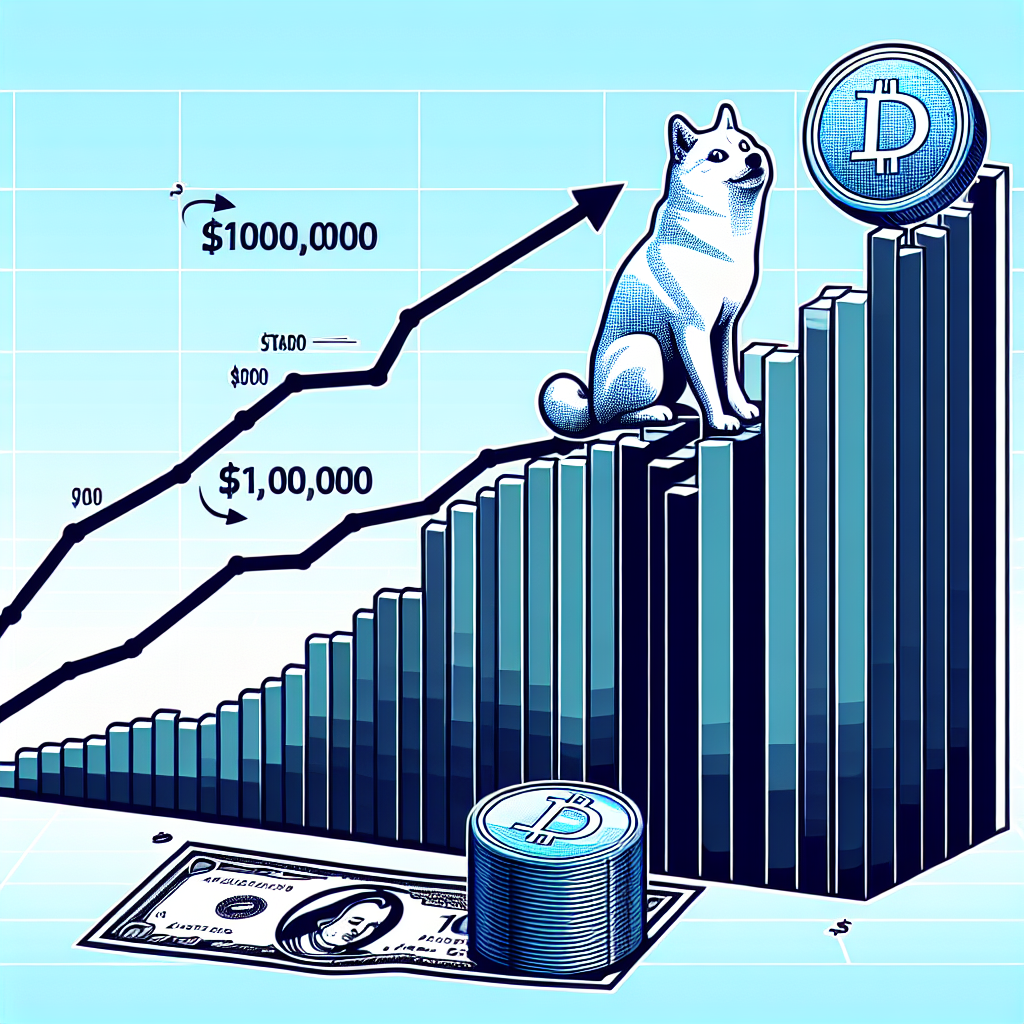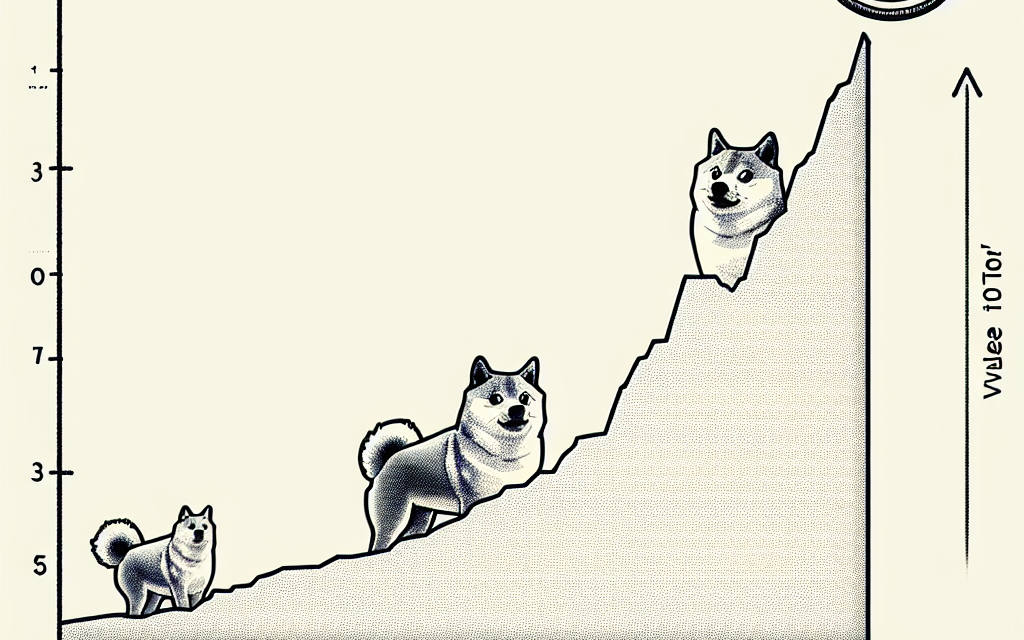“From Pennies to Potential: Discover the Journey of $100 in Dogecoin from Launch to Today!”
Introduction
Dogecoin, a cryptocurrency that began as a meme in 2013, has experienced significant fluctuations in value over the years. Initially launched with a price of $0.00026 per coin, Dogecoin was largely considered a novelty in the burgeoning world of digital currencies. However, its community-driven approach and viral popularity, often fueled by social media and high-profile endorsements, have led to substantial increases in its market value. For those who invested early, the returns have been remarkable. To illustrate, an investment of $100 in Dogecoin at its launch price would have purchased approximately 384,615 DOGE. As of recent valuations, where Dogecoin has reached prices upwards of $0.30 per coin, that initial $100 investment would be worth over $115,000, showcasing the potential for exponential growth in the cryptocurrency market.
Historical Overview Of Dogecoin’s Launch And Initial Value
Dogecoin, a cryptocurrency that began as a lighthearted joke, has evolved into a significant player in the digital currency market. Launched on December 6, 2013, by software engineers Billy Markus and Jackson Palmer, Dogecoin was initially intended to be a fun and friendly alternative to Bitcoin. The currency’s mascot, a Shiba Inu dog from the popular “Doge” meme, quickly captured the internet’s attention, contributing to its viral spread. At its inception, Dogecoin was valued at a fraction of a cent, specifically around $0.00026 per coin. This low entry price made it accessible to a wide audience, encouraging many to invest small amounts for entertainment rather than serious financial gain.
To understand the potential value of an early investment in Dogecoin, consider the hypothetical scenario of purchasing $100 worth of Dogecoin at its launch. At the initial price of $0.00026, this investment would have secured approximately 384,615 Dogecoins. Over the years, Dogecoin’s value has experienced significant fluctuations, driven by various factors including market trends, social media influence, and endorsements from high-profile individuals such as Elon Musk. These fluctuations have contributed to Dogecoin’s reputation as a volatile yet intriguing investment option.
As the cryptocurrency market matured, Dogecoin began to gain traction beyond its meme origins. The community surrounding Dogecoin played a crucial role in its growth, organizing charitable events and fundraising initiatives that showcased the currency’s potential for positive impact. This community-driven approach helped to solidify Dogecoin’s place in the broader cryptocurrency ecosystem, attracting both casual enthusiasts and serious investors.
Fast forward to 2021, a year that marked a turning point for Dogecoin. The cryptocurrency experienced a meteoric rise, reaching an all-time high of approximately $0.74 in May. This surge was fueled by a combination of social media buzz, celebrity endorsements, and a growing acceptance of cryptocurrencies as legitimate financial instruments. For those who had invested in Dogecoin at its launch, this price peak represented a staggering increase in value. Specifically, the initial $100 investment would have been worth approximately $284,615 at the height of Dogecoin’s 2021 rally.
However, it is important to note that the cryptocurrency market is inherently volatile, and Dogecoin’s value has since experienced declines and recoveries. Despite these fluctuations, the currency has maintained a significant presence in the market, with a dedicated community and ongoing interest from investors. This enduring appeal underscores the unpredictable yet potentially rewarding nature of investing in cryptocurrencies.
In conclusion, the journey of Dogecoin from a humorous digital token to a widely recognized cryptocurrency highlights the dynamic and often unpredictable nature of the digital currency market. An initial investment of $100 in Dogecoin at its launch would have yielded substantial returns during its peak, illustrating the potential for significant financial gain. However, the volatility of the market also serves as a reminder of the risks associated with cryptocurrency investments. As Dogecoin continues to evolve, its historical trajectory offers valuable insights into the factors that drive the success and challenges of digital currencies in the modern financial landscape.
Calculating The Growth Of Dogecoin From Launch To Present
Dogecoin, a cryptocurrency that began as a lighthearted joke, has evolved into a significant player in the digital currency market. Launched on December 6, 2013, by software engineers Billy Markus and Jackson Palmer, Dogecoin was initially intended to be a fun and friendly alternative to Bitcoin. Despite its humorous origins, Dogecoin has garnered a substantial following and has seen remarkable growth over the years. To understand the extent of this growth, it is intriguing to consider how much an initial investment of $100 in Dogecoin at its launch would be worth today.
At the time of its launch, Dogecoin was priced at a fraction of a cent. Specifically, on December 15, 2013, Dogecoin was valued at approximately $0.00026. With an investment of $100, one could have acquired approximately 384,615 Dogecoins. This initial purchase, seemingly insignificant at the time, would lay the foundation for a potentially lucrative investment.
Over the years, Dogecoin’s value has experienced significant fluctuations, influenced by various factors including market trends, social media influence, and broader acceptance of cryptocurrencies. Notably, Dogecoin’s value surged dramatically in early 2021, driven in part by endorsements from high-profile individuals such as Elon Musk and widespread attention on social media platforms like Reddit. This surge propelled Dogecoin into the mainstream consciousness, leading to a substantial increase in its market value.
By May 2021, Dogecoin reached an all-time high of approximately $0.74. At this peak, the initial investment of $100 would have been worth an astonishing $284,615. This remarkable increase highlights the potential for exponential growth within the cryptocurrency market, albeit accompanied by significant volatility and risk.
However, it is important to note that the value of Dogecoin, like many cryptocurrencies, is subject to rapid changes. Following its peak, Dogecoin’s value experienced a decline, reflecting the inherent volatility of the cryptocurrency market. As of October 2023, Dogecoin’s value has stabilized to some extent, trading at around $0.06. Consequently, the initial $100 investment would now be worth approximately $23,077. While this is a significant decrease from its peak value, it still represents a substantial return on the original investment.
The journey of Dogecoin from its inception to its current status underscores the unpredictable nature of cryptocurrencies. While the potential for high returns exists, it is accompanied by considerable risk and uncertainty. Investors must exercise caution and conduct thorough research before engaging in cryptocurrency investments, as market conditions can change rapidly.
In conclusion, the hypothetical scenario of investing $100 in Dogecoin at its launch provides a fascinating insight into the potential growth and volatility of cryptocurrencies. While the initial investment could have yielded substantial returns at its peak, the fluctuating nature of the market serves as a reminder of the risks involved. As cryptocurrencies continue to evolve and gain acceptance, they present both opportunities and challenges for investors. Understanding these dynamics is crucial for anyone considering entering the world of digital currencies.
Factors Influencing Dogecoin’s Price Fluctuations Over Time
Dogecoin, a cryptocurrency that began as a meme, has experienced significant price fluctuations since its launch in December 2013. Understanding the factors that have influenced its value over time provides insight into the volatile nature of cryptocurrencies. Initially, Dogecoin was created as a lighthearted alternative to Bitcoin, featuring the Shiba Inu dog from the “Doge” meme as its logo. Despite its humorous origins, Dogecoin quickly gained a dedicated community, which played a crucial role in its early adoption and subsequent price movements.
One of the primary factors influencing Dogecoin’s price has been its community-driven nature. The Dogecoin community has been instrumental in promoting the cryptocurrency through various charitable initiatives and sponsorships, such as funding the Jamaican bobsled team for the 2014 Winter Olympics. These efforts have not only increased Dogecoin’s visibility but also fostered a sense of goodwill and camaraderie among its supporters. This community engagement has often led to spikes in Dogecoin’s price, as increased media attention and public interest drive demand.
Another significant factor affecting Dogecoin’s price is its inflationary supply model. Unlike Bitcoin, which has a capped supply of 21 million coins, Dogecoin has no maximum supply limit. Instead, it has a fixed issuance rate of 10,000 coins per minute, resulting in an ever-increasing supply. This inflationary model can exert downward pressure on Dogecoin’s price, as the continuous creation of new coins dilutes the value of existing ones. However, the impact of this inflationary pressure is often mitigated by periods of heightened demand, which can temporarily boost prices.
Market sentiment and speculation also play a crucial role in Dogecoin’s price fluctuations. As with many cryptocurrencies, Dogecoin’s value is heavily influenced by investor sentiment and market trends. Positive news, such as endorsements from high-profile individuals like Elon Musk, can lead to rapid price increases as investors rush to capitalize on the perceived opportunity. Conversely, negative news or regulatory concerns can trigger sharp declines as investors seek to minimize their risk exposure. This speculative nature makes Dogecoin’s price highly volatile and subject to sudden changes.
Technological developments and improvements in the broader cryptocurrency ecosystem have also impacted Dogecoin’s price over time. As the cryptocurrency market has matured, advancements in blockchain technology and increased adoption of digital currencies have contributed to a more favorable environment for Dogecoin. For instance, the integration of Dogecoin into popular cryptocurrency exchanges and payment platforms has made it more accessible to a wider audience, thereby increasing its potential user base and demand.
Finally, macroeconomic factors and global events can influence Dogecoin’s price, as they do with other financial assets. Economic uncertainty, geopolitical tensions, and changes in monetary policy can drive investors to seek alternative assets like cryptocurrencies, including Dogecoin, as a hedge against traditional market risks. This increased interest can lead to price fluctuations as investors adjust their portfolios in response to changing economic conditions.
In conclusion, the value of $100 invested in Dogecoin at its launch would have experienced significant fluctuations due to a variety of factors. Community engagement, inflationary supply, market sentiment, technological advancements, and macroeconomic conditions have all played a role in shaping Dogecoin’s price trajectory. Understanding these influences provides valuable insight into the dynamic and often unpredictable nature of cryptocurrency markets.
Comparing Dogecoin’s Performance To Other Cryptocurrencies

Dogecoin, a cryptocurrency that began as a lighthearted joke, has evolved into a significant player in the digital currency market. Launched in December 2013 by software engineers Billy Markus and Jackson Palmer, Dogecoin was initially intended to be a fun and friendly alternative to Bitcoin. Despite its humorous origins, Dogecoin has captured the attention of investors and enthusiasts alike, leading to substantial growth over the years. To understand its performance, it is insightful to consider how much an initial investment of $100 in Dogecoin at its launch would be worth today, especially when compared to other cryptocurrencies.
At its inception, Dogecoin was priced at a fraction of a cent, making it accessible to a wide range of investors. Specifically, the price was approximately $0.00026 per Dogecoin. With a $100 investment at that time, an investor could have acquired around 384,615 Dogecoins. Fast forward to recent times, Dogecoin has experienced significant price fluctuations, driven by various factors including social media influence, celebrity endorsements, and broader market trends. As of October 2023, Dogecoin’s price hovers around $0.06. Consequently, the initial $100 investment would now be worth approximately $23,077, illustrating a remarkable return on investment.
When comparing Dogecoin’s performance to other cryptocurrencies, it is essential to consider the broader context of the cryptocurrency market. Bitcoin, the first and most well-known cryptocurrency, has also seen substantial growth since its launch in 2009. An investment of $100 in Bitcoin at its launch, when the price was negligible, would be worth millions today. Ethereum, another major player in the cryptocurrency space, launched in 2015. A $100 investment in Ethereum at its initial coin offering (ICO) price of around $0.30 would have yielded a significant return, given Ethereum’s current price of over $1,500.
Despite not reaching the astronomical heights of Bitcoin or Ethereum, Dogecoin’s performance is noteworthy due to its unique position in the market. Unlike Bitcoin, which is often viewed as a store of value, or Ethereum, which is known for its smart contract capabilities, Dogecoin has carved out a niche as a community-driven and meme-centric cryptocurrency. This distinct identity has contributed to its resilience and popularity, particularly among retail investors.
Moreover, Dogecoin’s journey highlights the unpredictable nature of the cryptocurrency market. While some investors have reaped substantial rewards, others have faced losses due to the market’s inherent volatility. This unpredictability underscores the importance of conducting thorough research and exercising caution when investing in cryptocurrencies.
In conclusion, the hypothetical scenario of investing $100 in Dogecoin at its launch provides valuable insights into the cryptocurrency’s performance relative to its peers. While it may not have achieved the same level of financial success as Bitcoin or Ethereum, Dogecoin’s growth is a testament to its enduring appeal and the dynamic nature of the cryptocurrency market. As digital currencies continue to evolve, Dogecoin’s story serves as a reminder of the potential rewards and risks associated with investing in this rapidly changing landscape.
The Impact Of Market Trends On Dogecoin’s Value
Dogecoin, a cryptocurrency that began as a lighthearted joke, has evolved into a significant player in the digital currency market. Launched in December 2013, Dogecoin was initially created by software engineers Billy Markus and Jackson Palmer as a fun and friendly alternative to Bitcoin. Despite its humorous origins, Dogecoin has experienced substantial growth, driven by market trends and social media influence. To understand the impact of these trends on Dogecoin’s value, it is insightful to consider how much an initial investment of $100 at its launch would be worth today.
At its inception, Dogecoin was priced at a fraction of a cent, specifically around $0.00026 per coin. With $100, an investor could have acquired approximately 384,615 Dogecoins. Over the years, Dogecoin’s value has been subject to the volatile nature of the cryptocurrency market, influenced by various factors such as technological advancements, market sentiment, and the broader acceptance of cryptocurrencies.
One of the most significant factors contributing to Dogecoin’s rise in value has been its strong community support and social media presence. Platforms like Reddit and Twitter have played a crucial role in promoting Dogecoin, often through memes and viral campaigns. This grassroots support has helped maintain interest in the cryptocurrency, even during periods of market downturns. Furthermore, high-profile endorsements from celebrities and entrepreneurs, most notably Elon Musk, have propelled Dogecoin into the mainstream consciousness, leading to dramatic price surges.
In addition to social media influence, the broader acceptance of cryptocurrencies as a legitimate form of investment has also contributed to Dogecoin’s increased value. As more businesses and financial institutions begin to recognize and accept digital currencies, the demand for cryptocurrencies, including Dogecoin, has risen. This growing acceptance has been further bolstered by technological advancements in blockchain technology, which have improved the security and efficiency of cryptocurrency transactions.
Moreover, the speculative nature of the cryptocurrency market has played a significant role in Dogecoin’s value fluctuations. Investors, driven by the potential for high returns, have often engaged in speculative trading, leading to rapid price changes. This speculative behavior, while contributing to short-term volatility, has also resulted in long-term gains for early investors.
As of October 2023, Dogecoin’s price has experienced significant appreciation since its launch. Although the cryptocurrency market remains volatile, Dogecoin has managed to maintain a relatively stable position among the top cryptocurrencies by market capitalization. If an investor had held onto their initial $100 investment from 2013, their Dogecoin holdings would be worth a substantial amount today, reflecting the cryptocurrency’s remarkable growth over the past decade.
In conclusion, the value of Dogecoin has been significantly impacted by market trends, including social media influence, increased acceptance of cryptocurrencies, and speculative trading. These factors have contributed to Dogecoin’s transformation from a niche internet joke to a widely recognized digital asset. While the cryptocurrency market remains unpredictable, the journey of Dogecoin serves as a testament to the power of community support and the potential for growth in the ever-evolving world of digital currencies. As such, the hypothetical $100 investment at Dogecoin’s launch exemplifies the profound impact that market trends can have on the value of cryptocurrencies over time.
Analyzing The Role Of Social Media In Dogecoin’s Popularity
Dogecoin, a cryptocurrency that began as a meme, has experienced a remarkable journey since its inception. Launched in December 2013 by software engineers Billy Markus and Jackson Palmer, Dogecoin was initially intended as a lighthearted alternative to Bitcoin. However, its trajectory has been anything but trivial, largely due to the significant role social media has played in its popularity. To understand the impact of social media on Dogecoin’s value, one must first consider the hypothetical scenario of investing $100 in Dogecoin at its launch. This scenario provides a lens through which the influence of social media can be examined.
At its launch, Dogecoin was valued at a fraction of a cent, making it an accessible investment for many. If an individual had invested $100 in Dogecoin at that time, they would have acquired a substantial number of coins. Fast forward to the present day, and the value of that initial investment has fluctuated dramatically, largely due to the influence of social media platforms. Social media has served as a catalyst for Dogecoin’s popularity, with platforms like Twitter, Reddit, and TikTok playing pivotal roles in its rise.
Twitter, in particular, has been instrumental in driving interest in Dogecoin. High-profile endorsements from influential figures, such as Elon Musk, have significantly impacted the cryptocurrency’s value. Musk’s tweets, often playful and cryptic, have led to substantial price surges, demonstrating the power of social media in shaping market dynamics. This phenomenon underscores the importance of social media as a tool for both information dissemination and market manipulation, highlighting its dual role in the cryptocurrency landscape.
Reddit, another influential platform, has also contributed to Dogecoin’s popularity. The subreddit r/dogecoin has fostered a community of enthusiasts who share news, memes, and investment strategies. This sense of community has been crucial in maintaining interest in Dogecoin, even during periods of market volatility. The collective enthusiasm and shared identity among Reddit users have helped sustain Dogecoin’s relevance, illustrating the power of social media communities in driving engagement and investment.
Moreover, TikTok has emerged as a surprising player in the Dogecoin narrative. Viral videos promoting Dogecoin as a lucrative investment opportunity have reached millions of users, further amplifying its appeal. The platform’s algorithm, which favors engaging and shareable content, has enabled Dogecoin-related videos to gain significant traction, thereby attracting a younger demographic to the cryptocurrency market. This highlights the evolving nature of social media’s influence, as new platforms continue to shape investment trends and consumer behavior.
In conclusion, the hypothetical value of a $100 investment in Dogecoin at its launch serves as a testament to the profound impact of social media on its popularity. The interplay between social media platforms and cryptocurrency markets has created a unique environment where information, community, and influence converge to drive value. As Dogecoin continues to capture the public’s imagination, the role of social media remains a critical factor in its ongoing evolution. This dynamic underscores the need for investors to remain vigilant and informed, as the power of social media can both elevate and destabilize market trends in equal measure.
Lessons Learned From Dogecoin’s Market Journey
Dogecoin, initially introduced as a meme cryptocurrency in December 2013, has experienced a remarkable journey in the volatile world of digital currencies. Created by software engineers Billy Markus and Jackson Palmer, Dogecoin was intended as a lighthearted alternative to Bitcoin, featuring the Shiba Inu dog from the popular “Doge” meme as its logo. Despite its humorous origins, Dogecoin has captured the attention of investors and enthusiasts alike, leading to significant fluctuations in its market value over the years. To understand the lessons learned from Dogecoin’s market journey, it is insightful to consider how much an initial investment of $100 at its launch would be worth today.
At its inception, Dogecoin was valued at a fraction of a cent, making it accessible to a wide range of investors. Specifically, on December 6, 2013, Dogecoin was priced at approximately $0.00026. An investment of $100 at that time would have allowed an investor to acquire approximately 384,615 Dogecoins. Over the years, Dogecoin’s value has experienced dramatic ups and downs, influenced by various factors including market trends, social media influence, and broader economic conditions.
One of the most significant surges in Dogecoin’s value occurred in early 2021, driven largely by social media campaigns and endorsements from high-profile individuals such as Elon Musk. By May 2021, Dogecoin reached an all-time high of around $0.74. At this peak, the initial $100 investment would have been worth approximately $284,615, illustrating the potential for substantial returns in the cryptocurrency market. However, this peak was short-lived, as Dogecoin’s value subsequently declined, highlighting the inherent volatility and risk associated with investing in cryptocurrencies.
The journey of Dogecoin offers several lessons for investors and market participants. Firstly, it underscores the importance of understanding market volatility. Cryptocurrencies, including Dogecoin, are subject to rapid and unpredictable price changes, which can result in significant gains or losses. Investors must be prepared for this volatility and consider their risk tolerance before entering the market.
Secondly, Dogecoin’s rise to prominence highlights the impact of social media and public sentiment on cryptocurrency prices. The influence of platforms like Twitter and Reddit, along with endorsements from influential figures, can drive significant price movements. This phenomenon emphasizes the need for investors to stay informed about social media trends and their potential impact on market dynamics.
Furthermore, Dogecoin’s journey illustrates the potential for meme-based or community-driven projects to gain traction in the cryptocurrency space. While initially dismissed by some as a joke, Dogecoin has demonstrated that community support and engagement can play a crucial role in a cryptocurrency’s success. This lesson is particularly relevant for new projects seeking to establish themselves in a crowded and competitive market.
In conclusion, the hypothetical scenario of investing $100 in Dogecoin at its launch provides valuable insights into the cryptocurrency market’s dynamics. While the potential for significant returns exists, so too does the risk of substantial losses. As Dogecoin’s journey has shown, understanding market volatility, the influence of social media, and the power of community support are essential considerations for anyone navigating the complex world of cryptocurrencies. These lessons serve as a reminder of the importance of thorough research and careful decision-making in the ever-evolving landscape of digital assets.
Q&A
1. **What was the launch price of Dogecoin?**
Dogecoin was launched in December 2013 at a price of approximately $0.00026 per coin.
2. **How many Dogecoins would $100 buy at launch?**
At the launch price of $0.00026, $100 would buy approximately 384,615 Dogecoins.
3. **What is the all-time high price of Dogecoin?**
Dogecoin reached an all-time high of about $0.73 in May 2021.
4. **How much would $100 in Dogecoin at launch be worth at its all-time high?**
At $0.73 per coin, 384,615 Dogecoins would be worth approximately $280,961.
5. **What is the current price of Dogecoin?**
As of the latest data in October 2023, Dogecoin is priced around $0.06.
6. **How much would $100 in Dogecoin at launch be worth today?**
At $0.06 per coin, 384,615 Dogecoins would be worth approximately $23,077.
7. **What factors have influenced Dogecoin’s price changes?**
Dogecoin’s price has been influenced by factors such as social media trends, endorsements by celebrities like Elon Musk, market speculation, and overall cryptocurrency market trends.
Conclusion
Dogecoin was launched in December 2013 with a price of approximately $0.00026 per coin. If you had invested $100 at that time, you would have acquired about 384,615 Dogecoins. As of October 2023, Dogecoin’s price is around $0.06. Therefore, the value of your initial $100 investment would be approximately $23,077. This significant increase highlights the potential for substantial returns in the cryptocurrency market, albeit with high volatility and risk.





